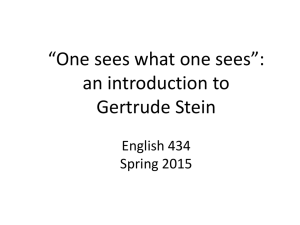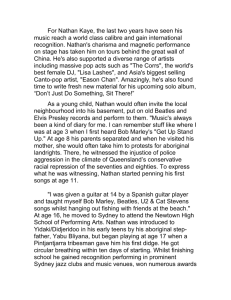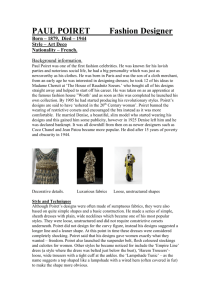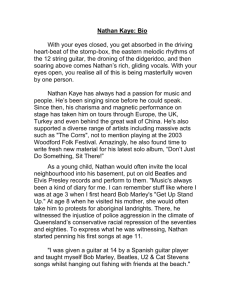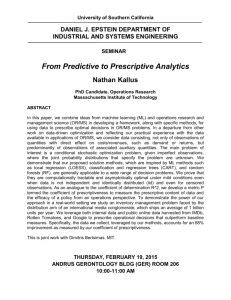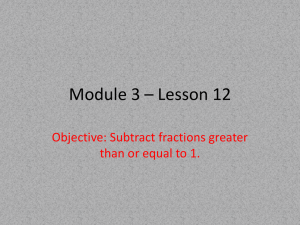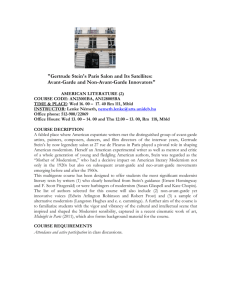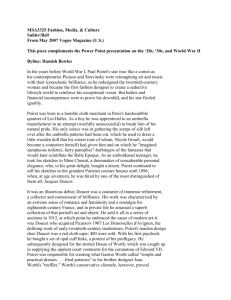your own copy - Arden Theatre Company
advertisement
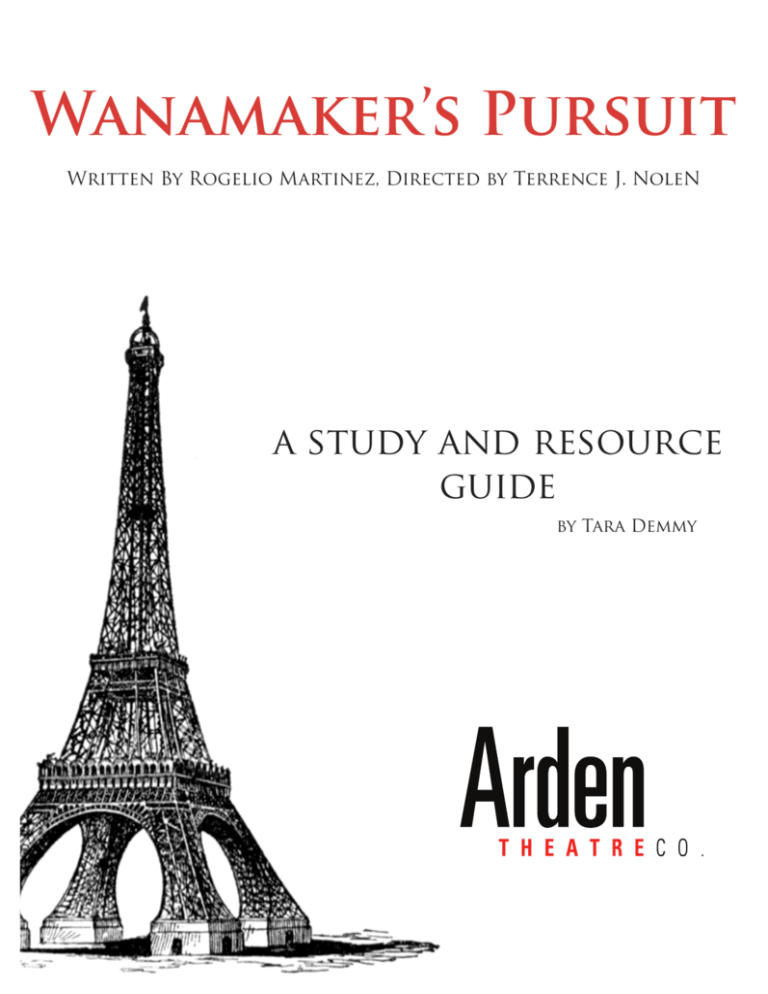
Wanamaker’s Pursuit Written By Rogelio Martinez, Directed by Terrence J. NoleN a study and resource guide by Tara Demmy Contents Section One: 2-15 The Play Section Two: 16-24 Context Section Three: 25-31 Our Production Photo by Mark Garvin 1 playwright biography Rogelio Martinez Rogelio Martinez is an award winning playwright whose work has been developed and produced by some of the largest regional theaters across the country. Plays include When Tang Met Laika (Sloan Grant/ Denver Center Theatre Co.), All Eyes and Ears (INTAR @ Theater Row), Fizz (NEA/ TCG Grant/Besch Solinger Productions at the Ohio Theatre, New Theater, Miami), and Arrivals and Departures (Summer Play Festival). Martinez’s play I Regret She’s Made of Sugar won the prestigious Princess Grace Award and will be published by Broadway Play Publishing later this year. He has received commissions from the Mark Taper Forum, the Atlantic Theater Company, Arden Theatre Company, and South Coast Repertory to list a few. Martinez was born in Cuba and arrived in this country in 1980 during the Mariel boatlift. “Writing a play is a way of giving shape to your past” ~Rogelio Martinez 2 Characters and Setting Characters NATHAN WANAMAKER, 29 PAUL POIRET, 32, a fashion designer DENISE POIRET, his wife GERTRUDE STEIN, 37 LEO STEIN, 39, her brother LARUE, a french painter PICASSO, twenties FRANZ REICHELT MUSEUM GUARD WILBUR EDWIN HENRY as Paul Poiret, Photo by Mark Garvin Setting WILBUR EDWIN HENRY as Paul Poiret, Photo by Mark Garvin Paris, 1911 CATHARINE K. SLUSAR as Gertrude Stein, DAVID BARDEEN as Leo Stein, Photo by Mark Gravin 3 SYNOPSIS ACT 1. Scene 1. The play opens to Nathan reading aloud a letter he has written to his wife, Josephine. He tells her of his experiences in Paris thus far and his hope to start doing business. The lights shift to introduce the Stein’s atelier, its walls covered in modern art. Denise Poiret (French designer Paul Poiret’s wife and muse), Larue (a French painter) Leo Stein, and Gertrude Stein are all having a witty argument about how much one should chew their food. Nathan enters the atelier as LaRue is showing the Stein’s his painting that they had commissioned. Larue, not pleased with Gertrude’s apathetic response, takes the painting away to revise. Leo thinks Nathan is there to collect money. Denise and Nathan discuss America and his father’s department store and Leo returns with his checkbook as they are viewing Cezanne’s “Five Apples.” Nathan explains that he Nathan Wanamaker, of the Philadelphia department store, that he is not there to buy art but to ask their help to find Paul Poiret. He hopes to take the latest fashion back to the states. Nathan discovers that Denise is Poiret’s wife and that the Stein’s know him well. Larue enters to announce that the Mona Lisa has been stolen. Gertrude and Nathan discuss her self-portrait by Picasso, Gertrude’s book The Making of Americans, as well as his reasons for coming to Paris. The scene concludes with Nathan reading another letter to Josephine, telling her about Cezanne’s “Five Apples,” a painting that appears not finished. Act I. Scene 2 Poiret’s Shop Denise is half draped with fabric and Nathan nervously tries to avert his eyes. Denise explains to Nathan the difficulty always being on display and being someone’s muse. Poiret enters and continues to work on the garment draped on Denise. Poiret calls Nathan out on his lack of fashion knowledge and declares that America is a country that lacks culture (playfully assuming that an American therefore has stolen the Mona Lisa). Poiret advises Nathan to find a designer that is less daring and Nathan tries to convince him otherwise. Poiret’s fencing instructor enters and Nathan engages Poiret in match. Nathan blocks with ease and Poiret agrees to show him a piece of his collection. Denise enters wearing harem pants and Nathan refuses the idea, not knowing how his father would react to such a radical statement. The scene concludes with Nathan reciting a letter to his father, stating that he has met designers and had not yet decided on a date to return. Act I. Scene 3 The Louvre Gertrude sits near the empty Mona Lisa frame with her feet soaking in a tub with Leo, both waiting for Nathan to arrive. Nathan arrives and Gertrude philosophizes about journeys 4 SYNOPSIS and the promise of the future, she also describes a dream about Picasso. They discuss Picasso’s work and Gertrude tries to get Nathan to commission him, using Denise’s affection for Picasso to convince him further, he agrees. Gertrude tries to understand Nathan’s attraction to Denise, while Nathan tells Gertrude that he has already experienced love, with his wife, Josephine, who is dead. Nathan reads a letter again, to Josephine, telling her about the painting he has commissioned, questioning his sanity; can he love more than once? How can he accept his freedom? Act I. Scene 4 Poiret’s Shop Nathan and Poiret fence and discuss the pants shown to Nathan by Denise. Poiret compares his wife to the Mona Lisa, the fact that the Mona Lisa was commissioned by her husband and never paid for. He confides in Nathan that he fears Denise is having an affair. Poiret says he will help Nathan bring back his latest fashions if he will spy on Denise. Nathan agrees to attend the The Thousand and Second Night party and keep his eye on Poiret’s wife. Act I. Scene 5 A Café and the Eiffel Tower Nathan walks into a surprise birthday party with all of his Parisian friends at a café. He leaves the café and decides to visit the top of the Eiffel tower. Denise is already on the platform, they both laugh and drink wine. Denise explains her unhappiness with her husband, feeling as though no one sees her, only the clothing. An Austrian man, named Franz Reichelt, approaches them in a large coat. He tells them that he intends to fly off the Eiffel tower, to make history. He jumps and Nathan closes the act with a message to Josie, realizing that he needs to live fully. Act II. Scene 1 Nathan is reciting a letter to Josie, recounting memories, explaining that the constant letters need to perhaps cease in order for him to move on. Poiret’s Thousand and Second Night party is in full swing. LaRue and Gertrude bicker about his commissioned painting. Gertrude is more concerned with the many letters from publishers in America refusing her work. Leo and Nathan enter; LaRue tries to get Nathan to commission him. Poiret encourages them all to join the party and discusses Gertrude’s purchasing habits with Leo. Leo finally tells Larue that he does not like his company. Nathan asks Leo about Denise’s involvement with Picasso. Denise escapes from the large gold cage Poiret locked her in and talks with Nathan. They flirt and talk about the party, the night on the Eiffel tower, the Wanamaker department store. She confronts him about his deceased wife; he tells her that he hopes she will fall in love with him. Nathan recites a letter to his father asking for more time. Act II. Scene 2 Poiret’s Shop There are dresses lined up that Poiret is applying finishing touches to while Nathan talks 5 SYNOPSIS about the party. Poiret questions Nathan, asking if he spoke to Denise or saw her leaving the party with anyone. Poiret eventually reveals that Denise is missing and is afraid she is off with another man. Poiret shows Nathan his new collection, Nathan is impressed, but Poiret demands he find Denise before he will continue discussing his designs. Act II. Scene 3 Picasso’s Studio A man and a woman have a heated argument in French, Leo and Gertrude listen. Nathan enters and they all hear repetitive banging; Picasso is with his mistress. Nathan wants to open the door to discover if the woman is Denise; Gertrude stops him. Leo discusses the many artistic paths he attempted while Nathan is drawn to Picasso’s painting titled “Demoiselles d’Avignon.” The Steins leave and Picasso enters to find Nathan admiring his work. Picasso hands him a bag of stolen art to get rid of, Nathan is confused at this proposition. Picasso explains that he stole Iberian statues from the Louvre and needs to get rid of them so he is not accused of stealing the Mona Lisa. Nathan explains that he is the man who commissioned him. Denise emerges from the bathroom. Nathan tells her that Picasso does not love her, that he is willing to take her back to Philadelphia with him. She accuses him of lying, and asks him if he really loves her. Nathan grapples with his feelings and the loss of his wife, trying to convince Denise that her husband misses her. Act II. Scene 4 The Stein’s Atelier A few paintings are missing off the wall, a sign that something is changing. Gertrude calls Nathan a traitor for having Picasso arrested and tells him the Mona Lisa has been discovered and Picasso set free. Gertrude tells Nathan that her collection is being broken up as Leo is moving. Poiret enters and asks the Stein’s if they have heard from his wife, he is met with silence. Nathan asks him again about his collection, Poiret refuses to discuss anything until his wife is found. Nathan intrigues him with a branding plan, to have his name on his designs in America. Poiret refuses, feeling as though he is being used just for his name. Nathan says goodbye to Gertrude and recites a letter to his father, announcing his return to America. Act II. Scene 5 The Louvre Nathan sits looking at the Mona Lisa. He talks to the guard about the mystery of the painting, the gaurd mentions Vincenzo’s (a fellow worker and the painting’s thief) fixation with the woman’s smile. Nathan asks the guard to give Denise the handkerchief when she arrives. Nathan recites his last letter to Josie, stating that he has left Paris behind, though the memory of Denise remains. 6 GENEVIÈVE PERRIER as Denise Poiret, Photo by Mark Garvin LEARN FRENCH GENEVIÈVE PERRIER as Denise Poiret, Photo by Mark Garvin Translations of French Phrases In The PLAY Denise: Jamais - Never Ils sont completement fou- They are completely Mon Dieu- My God Trés bien- Very Good Ma chere femme- My dear/darling woman Ne vous déplacez pas- Don’t Move Cessez de taquiner - Stop teasing him. Charmeuse- charming Bon jour - Thank you. Larue: Monsieur- Mister/Sir S’il vous plait- Please Travail et du travail - Work and more Work Oui? - Yes? bete insensible - Insensitive Idiot crazy. Poiret: Naturellement- Naturally Parfait!- Perfect C’est inadmissable! - It’s untolerable/unacceptable Party: Joyeux Anniversaire! - Happy Birthday! Franz: Et vous la press? - And you’re the press? Fencing Instructor: Il est temps, Monsieur - It’s time, sir. 7 LEARN FRENCH Translations of Act II Scene 3 Where: Picasso’s Studio at the Laundry Boat. The door to the hallway is slightly ajar. The studio is crammed with canvases (unfinished), sketches, sculptures, dirty rags, and brushes. GERTRUDE and LEO are there.OFFSTAGE we can hear a fight between a man and a woman. The man has a strong accent. MAN Tu veux les chaussures? Prends-les. Prends toutes tes chaussures! MAN You want shoes? Take them. Take all your shoes! WOMAN Arrte! WOMAN Don’t!!! MAN Tu veux reprendre ta libert. Prends-la. MAN You want your freedom to go back. Have it. WOMAN Je t’aime. Je suis venue vers toiÑ MAN Et maintenant, tu n’es pas sure. WOMAN Tu tais fch contre moi. MAN Ah. Et tu penses que cela rendrait les choses plus faciles. WOMAN I love you. I came to you. MAN And now you’re not sure. WOMAN You were angry with me. MAN Ah.So that will make it better. WOMAN Tu dis n’importe quoi. WOMAN You make no sense. MAN Prends tes chaussures. MAN Take your shoes. Leo walks up to the door which is slightly ajar. Leo walks up to the door which is slightly ajar. He is hit by a pair of shoes. He is hit by a pair of shoes. 8 WOMAN Qu’est que tu fait!? WOMAN What are you doing!? MAN Putain de merde! MAN Whore! Gertrude pretends nothing is happening, but Leo seems concerned. He takes a step toward the argument only to by hit by several more pairs of shoes. Gertrude pretends nothing is happening, but Leo seems concerned. He takes a step toward the argument only to by hit by several more pairs of shoes. WOMAN Tu ne comprends pas combien je t’aime. WOMAN You don’t understand just how much I love you. MAN Je t’aime. MAN I love you. WOMAN Alors, pourquoi me traites-tu de cette facon. Je voulais juste faire quelque chose WOMAN Then why do you treat me this way. I just wanted to do something. MAN J’ etas a la campagne et tu tais avec un autre homme. MAN I was away in the country and you were with another man. WOMAN Non. Il n’y a qu’un homme pour moi. Toi. Ecoute moi, s’il te plait. Je t’aime. WOMAN No. There’s only one man. You. Listen please. I love you. CATHARINE K. SLUSAR as Gertrude Stein, DAVID BARDEEN as Leo Stein, SHAWN FAGAN as LaRue, GENEVIÈVE PERRIER as Denise Poiret, Photo by Mark Gravin 9 PASSPORT TO PARIS Paris sites Mentioned in the Play Les Halles *Known as “the belly of Paris” *used to be a huge open-air market in central paris (up until 1971, when it was moved out to the suburbs) Source: http://uk.reuters.com/article The Luxembourg Gardens *Located at the left bank of Paris, it surrounds Luxembourg Palace, built between 1615-1627 for Marie de Medicis. The uses of the palace have varied, it served as a prison during the revolution and now houses the Senate. *The Gardens have beautiful lawns and flowers, ponds, and statues. People of all ages enjoy these relaxing and luxurious gardens. Source: www.paris.org The Seine *River that runs through Paris, used as a major port for trade. Historically Paris has been attacked and occupied via this waterway. Source: http://www.discoverfrance.net 10 8 PASSPORT TO PARIS Paris sites Mentioned in the Play Montmartre *Located in the North of Paris, it is a tall hill (130 meters high), “the last village in the big city of Paris” *Known for the Basilica of the Sacré Cœur (a white domed 19th century basilica) and for having many nightclubs. *Saint Pierre de Montmartre is a 12th century church on the hill, the supposed location of the founding of the Jesuit order. *Many artists had studios or worked around the community of Montmartre such as Salvador Dalí, Amedeo Modigliani, Claude Monet, Pablo Picasso and Vincent van Gogh. Source: www.parisdigest.com Belleville *means “beautiful town” *northern neighborhood of Paris, located around Montmartre *Originally a French working class neighborhood, present day it is a multi-ethnic neighborhood, one of Paris’ two “chinatowns.” Source: www.paris.org The Louvre *One of the largest art museums in the world, representing artifacts from almost every civilization on earth *Most popular pieces include the Mona Lisa, the Venus de Milo, and the Winged Victory *The building was originally a fortress in the 13th century, then a royal residence. It was not a museum until the reign of Francois the I. *Napoleon contributed to the museum in the 19th century, as he would bring back items from his military campaigns. Source: paris.org 11 Gertrude Stein’s Quote Corner The lines from the play below are actual Gertrude Stein quotes, Were you able to pick any out during the production? “America is my country. Paris is my hometown.” “Once an angry man dragged his father along the ground through his own orchard. “Stop!” cried the groaning old man at last, “Stop! I did not drag my father beyond this tree.” “Do you know because I tell you so, or do you know, do you know.” “There is a difference between 29 and 30. When you’re 29 it can feel like the beginning of everything. When you are 30 it can be the end of everything.” Source: Poets.org “Argument is to me the air I breathe. Given any proposition, I cannot help believing the other side and defending it.” “A ROSE IS A ROSE IS A ROSE” CATHARINE K. SLUSAR as Gertrude Stein, Photo by Mark Gravin 12 JÜRGEN HOOPER as Nathan Wanamaker, Photo by Mark Garvin Nathan: “I need to go up to the ledge, look down, and not be afraid of what comes next.” Discussion Questions 1) What determines a place’s identity? 2) How does the character of Denise connect with the mystery associated with the Mona Lisa? 3) What are some relationships between business and art brought up by the play? 4) Have you ever felt like you had to go somewhere else in order to find meaning in the place you left? How do you interpret the character of Nathan, a new businessman being pushed in many different directions? 5) Why does Nathan continue to write letters to Josephine? How does this structure help to contextualize the action of the play? Poiret: “It’s an American for sure. A country lacking culture, a past, it must go out and acquire it.” WILBUR EDWIN HENRY as Paul Poiret, Photo by Mark Garvin 13 Is that what america is like? ~WORKSHOP~ Circle all the areas you have lived/visited in your life on the map below. What place do you consider “home”? Why? How do your experiences in each of these places culminate in how you define American culture? Denise: “I do love putting on a costume. It’s like walking into a strange city just after sunset. You don’t have a map. You don’t know anyone and, more importantly, no one knows you. Is that what America is like?” You can start over. GENEVIÈVE PERRIER as Denise Poiret, JÜRGEN HOOPER as Nathan Wanamaker, Photo by Mark Garvin 14 Cast Field Trips The Cast of Wanamaker’s Pursuit visited the Wanamaker’s Department Store (Now Macy’s) on 13th and Market for a special tour. They also visited the Philadelphia Art Museum to see some of Paul Poiret’s original dresses. Photos by Stephanie Cook 15 SECTION TWO: CONTEXT WANAMAKER’S DEPARTMENT STORE Nathan: “Yes. Before we open my grandfather, father, and myself we take this walk through the main concourse. All the young girls are ready at the counters and all the elevator boys are there on the first floor standing next to the elevators with the doors open ready to take customers up..... .......We take an elevator to the third floor and from there we can see it happen. It’s time. The doormen open every single door simultaneously. And everyone who walks in -- whether they know it or not -- it’s likely that they don’t -- is there for a need...a need that we somehow meet.” Even though it is now Macy’s, Wanamaker’s is a site that many Philadelphians admire and visit regularly. It is known for its famous Holiday Light Show, and while very unique to Philly, it started a revolution in department store commerce in the United States and abroad. 16 Wanamaker’s TimeLiNE courtesy of Historic Landmarks of Philadelphia by Roger W. Moss. 1861 – As the Civil War Breaks Out, John Wanamaker Opens His First Store – Known as Oak Hall – at 6th and Market Streets, near Independence Hall and the Liberty Bell John Wanamaker Source: xroads.virginia.edu *A Men’s Clothing Store where he was a pioneer in advertising (buying full page spreads in magazines and newspapers!) *He had both advanced machines for producing clothing fast, as well as in house tailors to customize clothing to individuals. *Coined the slogan ”Full Guarantee, One Price, Cash Payments, Cash Returns” He revolutionized the business by “guaranteeing customer satisfaction; offering no-haggle pricing – you didn’t have to negotiate; giving the customer the option to undo the transaction and refund his/her money, for any reason.” 1874 – Wanamaker Moves His Operation to 13th and Market Streets for the First Time, Opening “The New Establishment”, Selling Clothing, Fabrics, and Linens *Sold both men and women’s clothing as well as fabrics and linens. 1877 – The First Wanamaker Department Store Opens, Known as “The Grand Depot” 1878 – Wanamaker Opens a China Department 1880 – Wanamaker Becomes First Store to Install Thomas Edison’s Newly Invented Electric Lamps for Interior Lighting; Creates Departments for Sporting Goods, Refrigerators, Jewelry, and Carpets 1881 – Wanamaker Creates Departments for Antique Furniture, Gas Stoves, Art, Beds, and Eyeglasses 1882 – Wanamaker Installs a Soda Fountain and Begins Selling Books 1901 – Wanamaker Announces His Plan To Re- place The Grand Depot, and Construct The Building We Know Today, at 13th and Market Streets. *Took a decade to design and construct the new building December 30, 1911 – U.S. President William Howard Taft Gives Address Dedication of the New John Wanamaker Store The Wanamaker’s Eagle Source: frontpagenews.us 17 Wanamaker’s TimeLiNE courtesy of Historic Landmarks of Philadelphia by Roger W. Moss. “This notable edifice of ours takes its place as a central commanding figure in Philadelphia city life…, but more than this, it is a national building, specifically prepared to install the home of the new kind of store that originated here, embodying the new American mercantile system of retail commerce, which has spread over the world.” ~John Wanamaker, at President Taft Address Dedication Wanamaker’s Ad Source: joseflebovicgallery.com 1922 – The Death of John Wanamaker; His Family Continues the Business 1978 – The John Wanamaker Store Becomes A National Historic Landmark; the Wanamaker Family Sells the Chain To Other Department Stores 1995 – The Wanamaker Name Vanishes From All Stores; And Becomes Hecht’s, Temporarily 1997 – Wanamakers Becomes Lord & Taylor 1998 - The Year After the Wanamakers Name Vanishes From 13th and Market Streets, The Pennsylvania Historical and Museum Commission (PHMC) Places A Pennsylvania Historical Marker, Outside the John Wanamaker Store August 2006 – Wanamakers Becomes Macy’s, Which It Remains Today 18 Source: enjoyingphiladelphia.com Gertrude and Leo’s Collection The Stein’s Art Collection included work from Picasso, Matisse, Bonard, Cezanne, Daumier, Degas, Delacroix, Gauguin, Manet, Nadelman, Toulouse-Lautrec, Vallotton, and Renoir. Source: Four Americans in Paris, Museum of Modern Art, New York Picasso’s “Les Demoiselles d’Avignon” In the early 1900s, Leo and Gertrude’s home (whom they also shared with Gertrude’s companion Alice Toklas) was a “mecca for the modern-minded,” attracting poets, painters, intellectuals, English arisPicasso’s “Young Girl with Basket of tocrats, students, and other visiters aiming to see Flowers” the Steins’ avant-garde collection. Their living and dining room walls were covered in paintings and sketches (many that are now famous!). Source: www.nytimes.com/books/98/05/03 19 Gertrude and Leo’s Collection “I always wanted to be historical” - Gertrude Stein Renoir’s “Two Bathers” t, Source: Four Americans in Paris, Museum of Modern Art, New York Cezanne’s “Five Apples” “On a typical Saturday Evening, 60 years ago, one would have found Gertrude Stein at her post in the atelier, garbed in brown corduroy, sitting in a high-backed Renaissance chair, her legs dangling, next to the big cast-iron stove that heated the chilly room. A few feet away, on could hear Leo expounding to a group of visitors, his views on modern art.” In 1912, Leo and Gertrude parted and split their painting collection, Gertrude grabbing most of the Picassos and Leo taking the Renoirs and Cezannes. Matisse’s “Promenade among the Olive Trees” Source: www.nytimes.com/books/98/05/03 20 Historical Spotlight: Gertrude Stein Brief Biography: *Born in Allegheny, PA in 1874, moving to Vienna then Paris at the age of 3. *Studied Psychology at Radcliffe College and actually attended medical school for four years at Johns Hopkins University but did not recieve any formal degree. *In 1903 she returned to Paris with her companion Alice Toklas where she connected with new artists and writers who impacted her later writing. *She was known for her radical poetry style and indulgence in the abstract. *Her most important works include: The Making of Americans (1925) How to Write (1931) The Autobiography of Alice B. Toklas (1933) Stanzas in Meditation and Other Poems (1929-33) Source: metmuseum.org Relationship with Picasso: *This painting signifies Stein’s and Picasso’s link to eachother, as non-parisians creating art in Paris. *Picasso was always drawn to poets, but his connection to Gertrude Stein was unique, he was attracted to her strong presence and suggested to paint her portrait before even knowing her well. Gertrude had many of his works in her collection, encourged his career, and gave him great publicity at her and Leo’s Saturday salons. Her response to the painting was the following: “For me, it is I, and it is the only reproduction of me which is always I, for me.” *Stein’s body remained the same duriing their sittings but Picasso changed the head placement at least three times before completion. GERTRUDE: “At first he had me in profile but slowly on the canvas he turned me toward him. That was the moment we recognized one another’s genius.” Source: Four Americans in Paris, Museum of Modern Art, New York 21 Source: Poets.org, metmuseum.org Historical Spotlight: Paul Poiret and Denise Poiret *Known as “Poiret the Magnificient,” named for his pivotal role in women’s fashion in the early 1900s, breaking away from the corset and the petticoat, popularizing the bra, and freeing women of the strict dress codes of the 19th century. He also created his own perfume and threw fancy parties. *His fashion is best described as having “vibrant color combinations” and extensive draping. He created harem pants, the chemise ,culottes, dropped waists, and the lampshade skirt. *Not only did he invent new clothing designs but he paved the way for a new presentation and branding of fashion, one that incorporated art and interior design. Source: littleaugury.blogspot.com “I am an Artist, not a dressmaker” -Paul Poiret *Dedicated patron to the arts, admiring the work of Picasso, Matisse, Brancusi, and Modigliani. *Designed for remarkable European women (actresses, dancers) including Isadora Duncan. *Denise Poiret was his muse, model and artistic director of his company. *Denise and Paul Poiret divorced in 1928. The Thousand and Second Night Party *Famous costume party thrown in 1911 by Paul and Denise Poiret. *The party was to promote his own work and new collections. *Denise most likely “wore the heavily beaded green gauze lampshade-shaped tunic and pleated green silk gauze pantaloons,” currently on display at the Met. Source: littleaugury.blogspot.com 22 Source: artnet.com Historical Spotlight: FRANZ REICHELT *Austrian tailor *Thought he could create a suit that could double as a parachute and decided to test it by jumping off the Eiffel tower. *He gained access to the tower by telling authorities that he would use a dummy. *He fell for just about 5 seconds before hitting the ground, the fall was captured on film in 1912 and is available for viewing on YouTube.com SHAWN FAGAN as Franz Reichelt, Photo by Mark Garvin FRANZ: “Instructions for flying: Let the heart leap then the body will follow.” Source: Unmuseum.org 23 Source: junkworthknowing.com/disasters The Mona Lisa...STOLEN? Finding it missing: Louis Beroud, an artist known for copying famous paintings for tourists, discovered the missing painting on Tuesday morning (August 22, 1911). When he alerted the guard, he assumed that it had just been removed to be photographed (a new concept at the time!) They soon discovered it was not in the photography room, it had indeed been stolen. The Crime: The police suspected that the perpetrator hid over night in the museum on Sunday (after arriving as a visitor). The next day was Monday (Louvre is closed for maintenance) so the thief was able to slip into maintence garb and take the painting out via the service stairs (stripping it of its frame, later found in the stairway). He exited into the courtyard, and even though the courtyard door was locked, he was able to hide the painting (it’s only 21 X 30 inches!), and convince the Louvre plumber to open the door with his pliers, and slip by the courtyard gaurds. Suspects: When they realized the Mona Lisa had been stolen, the French sealed the borders, inspecting every ship and train leaving the country. They dusted the frame left in the stairwell and found a fingerprint (fingerprint identification still being new) and they called an expert. Unfortunately, it was a left fingerprint and only right fingerprints were kept on file at that time. Police investigated everyone that could have been connected to the crime, they even posted rewards outside the Louvre (with many magazines and newspapers contributing to the reward). Money was even offered to fortune tellers, who could possibly see into the future, they all assumed it had been destroyed. With public attention, rumors began to spread around Paris about who had stolen the piece, from a rich American (like JP Morgan) to a suspicious German plot. Source: pbs.com Finally Found: It was found on December 10, 1913 when a man approached a antique dealer in Florence by the name of Alfredo Geri. This man was named Vincenzo Perugia and he claimed to have the Mona Lisa. Geri brought the director of the Uffizi Gallery with him to Perugia’s hotel room. They requested to view the painting alone, and quickly brought it back to the Louvre who confirmed its authenticity. Peru-24 gia was arrested at his hotel and the Mona Lisa was safely returned to France. SECTION Three: production CATHARINE K. SLUSAR as Gertrude Stein, DAVID BARDEEN as Leo Stein, SHAWN FAGAN as LaRue, Photo by Mark Gravin Wanamaker’s Pursuit GENEVIÈVE PERRIER as Denise Poiret, JÜRGEN HOOPER as Nathan Wanamaker, Photo by Mark Garvin Scenic Designer JAMES KRONZER Dramaturg EDWARD SOBEL Costume Designer RICHARD ST. CLAIR Assistant Director DAN PLEHAL Sound Designer JORGE COUSINEAU Lighting Designer F. MITCHELL DANA Stage Manager STEPHANIE COOK Director Terrence J. Nolen 25 Scenic Designset model t, The Steins’ The Louvre 26 Scenic Designset model Poiret’s Shop The Eiffel Tower Picasso’s Apartment 27 Costume DesignSketches and Research Photos GENEVIÈVE PERRIER as Denise Poiret, Photo by Mark Garvin GENEVIÈVE PERRIER as Denise Poiret, Photo by Mark Garvin 28 Costume DesignSketches and Research Photos CATHARINE K. SLUSAR as Gertrude Stein, Photo by Mark Gravin JÜRGEN HOOPER as Nathan Wanamaker, Photo by Mark Garvin Source: Photos compiled for Inspiration by Costume Designer Richard St. Clair 29 Costume DesignSketches and Research Photos DAVID BARDEEN as Leo Stein, Photo by Mark Garvin WILBUR EDWIN HENRY as Paul Poiret, Photo by Mark Garvin Paul Poiret Source: Photos compiled for Inspiration by Costume Designer Richard St. Clair 30 Costume DesignSketches and Research Photos Pablo Picasso SHAWN FAGAN as Picasso, Photo by Mark Garvin SHAWN FAGAN as LaRue, Photo by Mark Garvin Pablo Picasso Source: Photos compiled for Inspiration by Costume Designer Richard St. Clair 31
